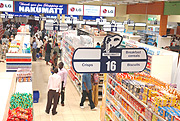STEPHEN TUMUSIIME discovers why it is more expensive to shop in Nakumatt Kigali than Nairobi To some shoppers, a journey to Nakumatt supermarket at Union Trade Centre is equivalent to a shopping trip to Kenya. Since the supermarket chain originates from Kenya, one would be excused for habouring such illusions.


STEPHEN TUMUSIIME discovers why it is more expensive to shop in Nakumatt Kigali than Nairobi
To some shoppers, a journey to Nakumatt supermarket at Union Trade Centre is equivalent to a shopping trip to Kenya. Since the supermarket chain originates from Kenya, one would be excused for habouring such illusions.
But it is simply that. An illusion according to an investigation carried out by the Sunday Times. Most commodity price commonly consumed by locals and available in both Kigali’s Nakumatt and Nairobi’s Nakumatt branches do differ.
A3 liter Elianto cooking oil jerry can that goes for Rwf 5380 in the Kigali’s Nakumatt is sold at Rfw4242 in Nairobi’s Nakumatt, while a 5 liter Rina cooking oil jerry can is sold at Rwf 7590 in Kigali where as the same can be bought at only Rwf 3885 in Kenya’s Nakumatt.
2 kilograms of Nakumatt sugar goes for Rfw1580 in the Kigali’s Nakumatt while the same can be bought at Rwf1150 in Kenya’s Nakumatt.
1 kilogram of salt is bought at Rwf 238 where as the same goes for Rwf150 in the Kenya’s Nakumatt. The 2 kilogram long grain white rice goes for Rfw2860 in the Kigali Nakumatt, whereas it can be bought at Rwf 2053 in the Kenya Nakumatt.
The 1 kilogram margarine (butter) tin that is priced at Rwf 2250 in the Kigali Nakumatt goes for an equivalent of Rfw1704 in the Kenya Nakumatt.
All the above differences in the prices are attributed to costs incurred in the transporting of these products from Kenya to Rwanda and the taxes involved.
An official in the Kigali’s Nakumatt who preferred anonymity, says that it is very costly to transport some of the products from different areas of the world to Rwanda than it is to Kenya.
In Kenya, goods are carried by Sea freight which is very cheap. But other costs are incurred while transporting the same goods to Kigali by road. This is not to mention the extra taxes.
These extra costs are transferred to the consumer when he opts to buy a product, thus the high cost of prices in the Kigali branch on Nakumatt.
However, it is understood that after the economic integration of the East African Community and the construction of a railway line connecting Rwanda to other countries products costs will drastically reduce and prices may not vary like they are today.
Ends




